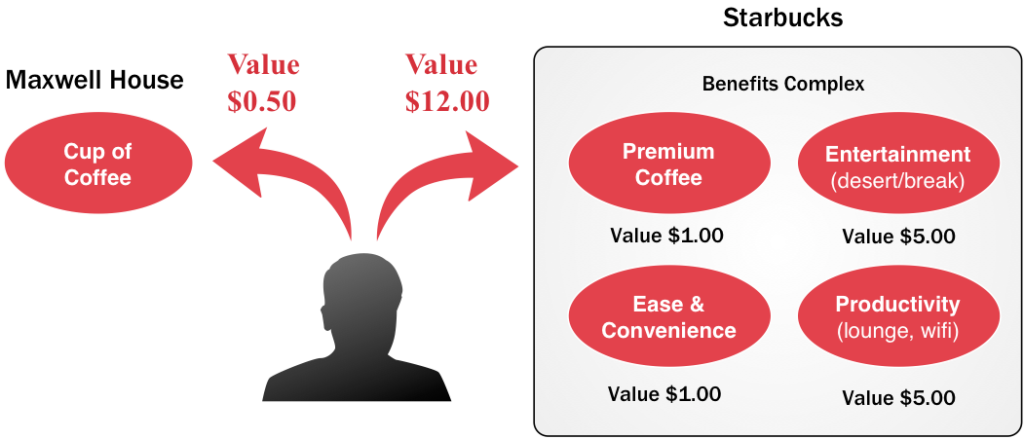Product Innovation Isn’t Everything
This article was originally posted on Inc.com.
How was Starbucks able to build an empire in just 35 years by charging premium prices for what is essentially a commodity? The coffee purveyor’s legions of loyal patrons seem to find significant value in what it offers, to the point that it has become one of America’s most beloved brands. Others, meanwhile, are perplexed by the fact that someone would pay $4 for a cup of coffee, standing in a long line for the opportunity to buy something that could be created at home for much less.
“If I went to a group of consumers and asked them if I should sell a $4 cup of coffee, what would they have told me?“ – Howard Schultz, Starbucks President.
So how does Starbucks pull it off? Because it offers more than just coffee. It prepares premium custom beverages made to your precise order, excellent customer service, and beautiful stores with comfortable chairs and free WiFi. For many, a trip to Starbucks is as much about the experience as it is about the caffeine. For others, it is a matter of convenience-they can always find one nearby when they need to connect to the Internet. All of these things add value beyond the coffee itself, which enables Starbucks to sell one of the World’s most commoditized products, at a significant premium. For those who value these benefits, Starbucks is contributing significant value, well worth the $4 per visit.

Amazon.com is a subtler example of what’s possible when we look beyond the commodity. It is not selling a premium version of a product like Starbucks, nor does it have a physical presence on every street corner. It does, however, contribute significant incremental value beyond that of its competitors. Most of us shop at Amazon.com because we know it has the world’s largest inventory, the fastest shipping, and one of the best return policies. And, because it is now the largest retailer in the world, it also has significant pricing power and is thus able to offer some of the best pricing.
If all of these benefits seem trivial, ask yourself if you would buy from a smaller online store you don’t know much about, even if the product is the same price. Perhaps you have a bias toward supporting the small businesses or the underdog, but that aside, would you pay the same price for a product from a store that has slower shipping and an unknown return policy?
In 1979, Harvard Professor Michael Porter introduced the concept of the value chain, suggesting there are multiple layers to your business, each of which contributes to the total value to your customer. Direct activities, including sales, clearly contribute to revenue, and activities such as IT and customer service provide indirect, long-term value. The presence of all of these services form an integrated value chain that makes some brands more professional and valuable than others. The investments these companies make in their infrastructure cannot only make them more efficient and bring down cost, they have the potential to add value for their customers by improving the purchase experience, reducing risk, and addressing other needs that the customer may have but are being ignored by the market.
Starbucks and Amazon.com have both built an empire around selling commodities, but they invested heavily in the indirect benefits surrounding their offerings, thus providing more value than their rivals. Put another way, their innovation is the value chain they wrapped around the commodity products they sell, not the products themselves. After all, innovation does not always mean technical wizardry or superior craftsmanship–creating a more valuable delivery or purchase experience can be fertile ground for innovation too.
How can you take a page from Starbucks or Amazon? First, you have to appreciate the irony of selling a commodity and yet become so differentiated in the process, that you rise above the commodity trap that plagues so many businesses. Therein lies a subtle, yet crucial, distinction. Everyone in Silicon Valley seems to be “innovating” a technology product, but not many are creating meaningful differentiated value that gives them a leg up on competitors. That is unfortunate when you consider that many technology products become commodities eventually.
The bottom line? If you spend all of your resources innovating a product that is bound to become a commodity, you won’t have a defensible market position down the road. In fact, all of your resources will have been spent fighting a battle you are unlikely to win in the long term, unless your successful at being acquired during market consolidation, which is unlikely. That’s why innovating the value chain around an existing commoditized product, rather than innovating the product itself, is sometimes a better strategy. That’s especially true if you’re entering a crowded space and lack the timing or resources to become a leader when the market matures.